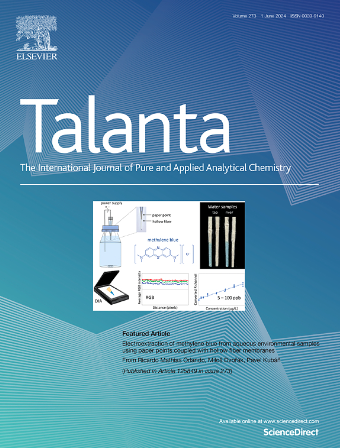润滑素(PRG4)防污涂层使检测细胞培养基中神经生长因子的免疫传感器得以发展
IF 6.1
1区 化学
Q1 CHEMISTRY, ANALYTICAL
引用次数: 0
摘要
生长因子(Growth factors, GFs)是一种独特的信号分子,能够实现细胞间的持续交流和反馈,调节细胞行为,维持组织的结构和功能。检测和量化GFs的传统方法,如ELISA,具有高特异性,但通常成本高,存在较低的检测限,通常需要样品处理,并且耗时。电化学传感因其快速响应和易于操作而成为一种有前途的替代方法;然而,当在复杂的生物环境中受到挑战时,它们容易发生生物污染。本研究将防污剂润滑素(LUB)引入电化学免疫传感器中,用于检测神经生长因子(NGF)。通过将特异的NGF抗体与LUB结合,所研制的传感器具有很高的灵敏度,对目标NGF的检出限为0.59 ng mL-1。我们的研究结果表明,与ELISA相比,所提出的传感结构可以直接在未处理和未稀释的细胞培养基中检测NGF,分析反应速度快得多。本文章由计算机程序翻译,如有差异,请以英文原文为准。

Lubricin (PRG4) antifouling coating enables the development of an immunosensor for the detection of nerve growth factor in cell culture media
Growth factors (GFs) are the unique signaling molecules that enable constant communication and feedback between cells, modulating cell behavior and maintaining the structure and function of tissues. Traditional methods to detect and quantify GFs, such as ELISA, offer high specificity but are usually costly, present lower limits of detection, typically require sample processing, and are time-consuming. Electrochemical sensing emerges as a promising alternative due to their rapid responses and easy operation; however, they are prone to biofouling when challenged in complex biological environments. This study introduces an antifouling agent, lubricin (LUB), into an electrochemical immunosensor for the detection nerve growth factor (NGF). Through the combination of a specific NGF antibody with LUB, the developed sensor presents a great sensitivity, achieving a limit detection of 0.59 ng mL-1 for the target NGF. Our results show that the proposed sensing configuration can detect NGF directly in unprocessed and undiluted cell culture media with much faster analytical responses when compared to ELISA.
求助全文
通过发布文献求助,成功后即可免费获取论文全文。
去求助
来源期刊

Talanta
化学-分析化学
CiteScore
12.30
自引率
4.90%
发文量
861
审稿时长
29 days
期刊介绍:
Talanta provides a forum for the publication of original research papers, short communications, and critical reviews in all branches of pure and applied analytical chemistry. Papers are evaluated based on established guidelines, including the fundamental nature of the study, scientific novelty, substantial improvement or advantage over existing technology or methods, and demonstrated analytical applicability. Original research papers on fundamental studies, and on novel sensor and instrumentation developments, are encouraged. Novel or improved applications in areas such as clinical and biological chemistry, environmental analysis, geochemistry, materials science and engineering, and analytical platforms for omics development are welcome.
Analytical performance of methods should be determined, including interference and matrix effects, and methods should be validated by comparison with a standard method, or analysis of a certified reference material. Simple spiking recoveries may not be sufficient. The developed method should especially comprise information on selectivity, sensitivity, detection limits, accuracy, and reliability. However, applying official validation or robustness studies to a routine method or technique does not necessarily constitute novelty. Proper statistical treatment of the data should be provided. Relevant literature should be cited, including related publications by the authors, and authors should discuss how their proposed methodology compares with previously reported methods.
 求助内容:
求助内容: 应助结果提醒方式:
应助结果提醒方式:


